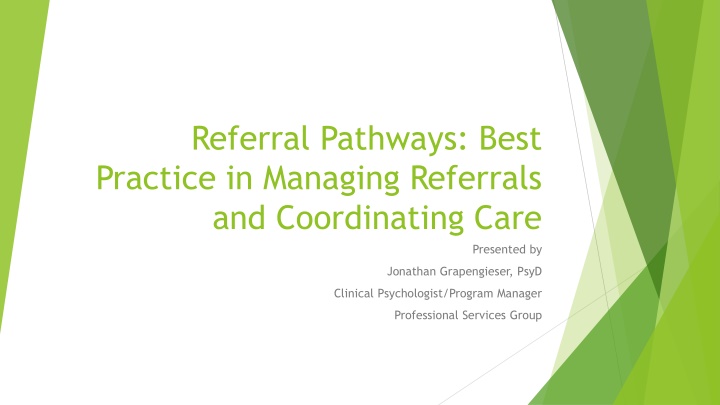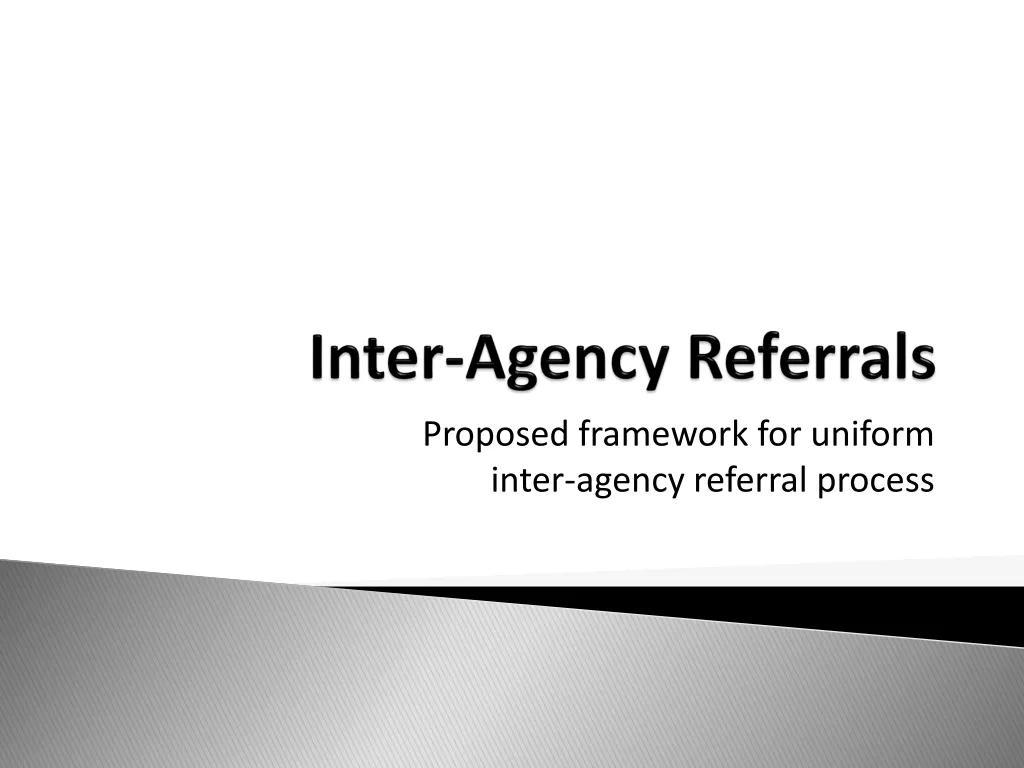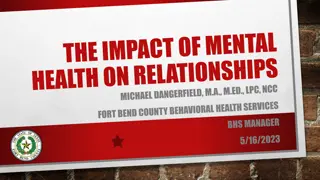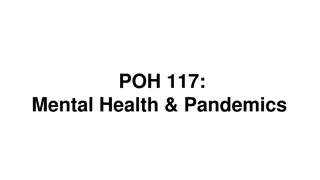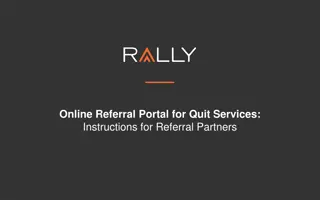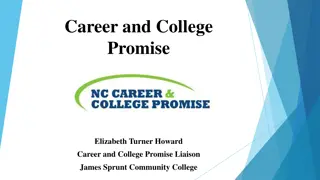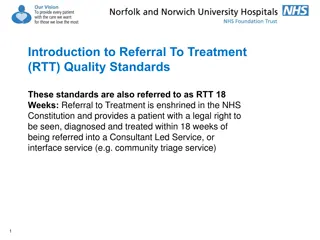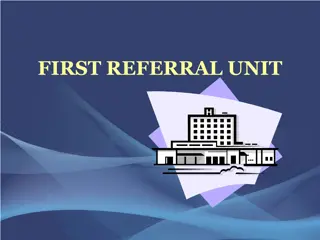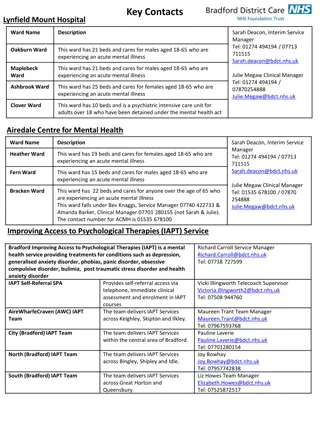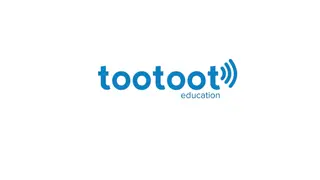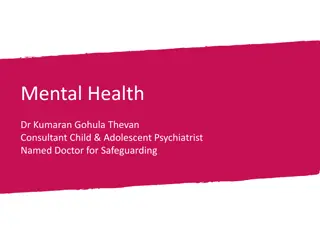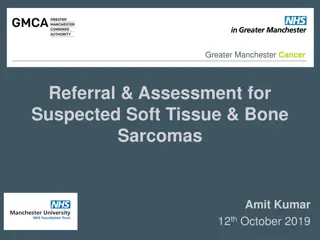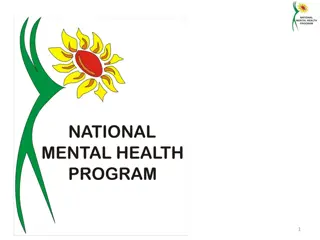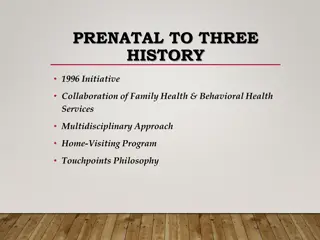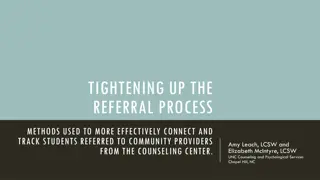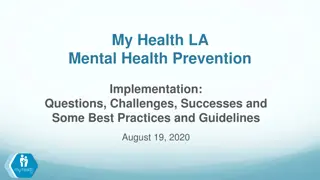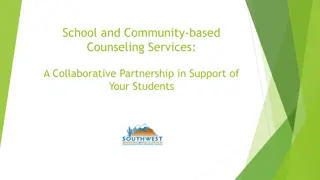Best Practices in Referral Pathways for School-Based Mental Health Services
This presentation by Jonathan Grapengieser, a clinical psychologist and program manager, delves into the importance of effective referral pathways in managing and coordinating care for school-based mental health services. It highlights the need for streamlined processes, stakeholder involvement, and collaborative decision-making to ensure optimal services. The content covers defining referral pathways, creating effective systems, common barriers, and strategies for success.
Download Presentation

Please find below an Image/Link to download the presentation.
The content on the website is provided AS IS for your information and personal use only. It may not be sold, licensed, or shared on other websites without obtaining consent from the author.If you encounter any issues during the download, it is possible that the publisher has removed the file from their server.
You are allowed to download the files provided on this website for personal or commercial use, subject to the condition that they are used lawfully. All files are the property of their respective owners.
The content on the website is provided AS IS for your information and personal use only. It may not be sold, licensed, or shared on other websites without obtaining consent from the author.
E N D
Presentation Transcript
Referral Pathways: Best Practice in Managing Referrals and Coordinating Care Presented by Jonathan Grapengieser, PsyD Clinical Psychologist/Program Manager Professional Services Group
Social services agency providing a variety of early intervention/prevention, delinquency, and clinical services in 10 counties throughout Wisconsin (Milwaukee, Kenosha, Racine, Washington, Rock, Winnebago, Outagamie, Portage, Marathon, and Langlade) Currently providing SBMH through various models in approximately 9 different school districts and over 30 schools including elementary, middle school, and high school levels. Providing Tier 2 and Tier 3 services through a variety of programming
Why school-based mental health (SBMH)? How do we deliver optimal services within SBMH? Initial Questions to Consider What are other people doing to streamline the process for referral within SBMH and what is truly most effective or best practice? Who are the stakeholders involved in creating an effective referral pathway for students and families to access SBMH?
Referral Pathways: Overview How do we define a referral pathway? Does our definition differ across communities? How do we begin to create an effective referral pathway? SAMHSA School Mental Health Referral Pathways Toolkit (2015)
Defining a Referral Pathway SAMHSA says referral pathways are defined as the series of actions or steps taken after identifying a youth with a potential mental health issue. (SAMHSA, 2015, p. 11) Pathways DO vary from community to community Common characteristics of effective referral pathways (SAMHSA, 2015): Defined roles and responsibilities of all partners in the system Clearly articulated procedures for managing referrals within and between partners Sharing of information across partners in an efficient manner Monitoring the effectiveness of evidence-based interventions provided by all parties in the system Intervention decisions made collaboratively with a priority on what is best for the youth and famlies
Build Referral Pathways that Work! Where do we start? Who needs to be involved? What resources are available? Common barriers in systems
Barriers in the Partnership and Referral Pathway Process Mis-understanding of roles Ineffective communication Engagement of parent/guardian Monitoring of referral status Lack of clear vision between partners Hurried implementation Lack of continuous monitoring of outcomes and implementation of changes
Getting Started and the Four Stages of Referral Pathway Self-Assessment Stage 1: Establish a Referral System Stage 4: Evaluate Intervention Effectiveness Stage 2: Manage Referral Flow Stage 3: Map Resources
Stage 1: Establish a Referral System Aim to build a system with several characteristics: Ability to manage all types of referral concerns Referral systems should be formalized A collaborative structure must exist to manage referrals Awareness of the referral process among those who will initiate referrals Sensitivity to developmental, cultural and linguistic diversity
Stage 1 (cont.): Establishing a Problem- Solving Team 1.) Assess Existing Teams 2.) Identify Team Members 3.) Articulate Team Purpose and Clarify Roles 4.) Establish Routines 5.) Re-assess Team Structure and Functioning
Initial considerations for managing the flow of referrals: Is there a standard referral form that will be used? What is included on this form? Stage 2: Manage Referral Flow Where will the form be available and in what format? Where will referrals be submitted? Who will review referral forms? How will procedures for submitting referral forms be communicated with the school and community stakesholders?
Stage 2 (cont.): Manage Referral Flow Defined decision making rules Record management system
Referral Form Important to include all desired information Collection of Background Information Items may include information about: Area of primary concern Behavioral Concerns History of Trauma Insurance or payer source information List of interventions already attempted or currently in place (both in school and outside) Contact information for parent/guardian Best time of day to pull student from class for services
Stage 3: Map Resources Examine the breadth and quality of interventions provided/available at school Examination of the issues associated with access to community-based resources Identify the resources available both school and community
Stage 4: Evaluate Intervention Effectiveness So we have a system in place, but is it working? Effectiveness should be measured in an observable and quantifiable manner when possible Who is responsible for collecting process and outcome data? Is the problem solving team requesting intervention effectiveness information from the community provider? What information should they request? Feedback from student and his/her family about the intervention experience Should intervention effectiveness data be shared with other stakeholders and who are these stakeholders?
Next Steps: Building Effective Partnerships
Who Belongs in the Partnership? Community Based Mental Health Providers Families Child-Serving Government Agencies School Personnel
Advantages to Partnerships in SBMH ACCESS! Ecologically Grounded Reduction in need for discipline practices, academic difficulties, school disengagement, drop out rates, and incarceration Increase in resources available to meet needs of students (Tier 1, Tier 2 and Tier 3)
Partnerships: Leveraging/Engaging Community Resources for Maximum Impact Youth are best served by engaging a large cross-section of community resources Mental Health Health and Medical Child Welfare Juvenile Justice Business and Philanthropic Organizations Government Agencies
Partnership Process Phase 1: Defining Roles and Responsibilities Sharing Planning for Transitions between Levels of Care Defining Roles and Responsibilities Information and Monitoring Progress Across Systems
Phase 2: Sharing Information and Monitoring Progress Across Sectors Clearly defined communication mechanism(s) Adherence to HIPAA and FERPA Elements of Consent to Release Information Tracking Referrals Across Partners Monitoring Treatment Progress
Phase 3: Planning for Transitions between Levels of Care Services are not forever What other options do we have available? Different options in different communities
Summary of Key Ingredients to Effective Referral Pathways Identification of appropriate stakeholders and problem-solving members COMMUNICATION Clearly defined roles of stakeholders True collaboration by all parties Developing Cultural and Linguistic Competence
Real World SBMH Different pathways in different places Disruption in the referral pathway is inevitable without strict procedures Efforts to standardize the referral process Streamline/reduce the number of people and steps as much as possible Mental Health Navigator Program with Navigator 89% of referrals have engaged in services Programs without Navigator 47 - 62% of referrals have engaged in services
References and Resources: Centers for Disease Control and Prevention (2013). Mental health surveillance among children in United States, 2005-2011. Morbidity and Mortality Weekly Report (MMWR), 62 (02), 1 35. Retrieved from http://www.cdc.gov/mmwr/preview/mmwrhtml.su6202a1.htm Eagle, J.W., & Dowd-Eagle, S.E. (2014). Best Practices in school-community partnerships. In P.L. Harrison, & A. Thomas (Eds.), Best practices in school psychology (pp.197 210. Bethesda, MD: National Association of School Psychologists Substance Abuse and Mental Health Services Administration (2000). Effective referrals and collaborations. Treatment Improvement Protocol Series, 38. Retrieved from http://www.ncbi.nlm.nih.gov/books/NBK64299 Substance Abuse and Mental Health Services Administration (2015). School mental health referral pathways (SMHRP) toolkit. Retrieved from https://knowledge.samhsa.gov/resources/school-mental-health-referral- pathways-toolkit
